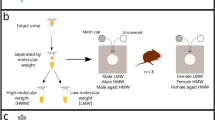Abstract
The European rabbit (Oryctolagus cuniculus) uses the secretion of the chin gland to maintain dominance hierarchies in the wild. Recent work has investigated changes in the secretion when social status is manipulated in the rabbit. When a rabbit becomes dominant, a new compound appears in his secretion, 2-phenoxyethanol. This compound is used as a fixative in the perfume industry. This study investigates whether the compound performs a similar function in the secretion of the rabbit. 2-Phenoxyethanol is not detected olfactorially by rabbits, and slows the release rate of some of the compounds that occur naturally in rabbit chin gland secretion. We suggest that when a rabbit becomes dominant, he adds a fixative to his secretion so that his scent will persist in the environment and not dissipate. He will thus come to dominate the olfactory environment, in much the same way as he does the physical environment.
Similar content being viewed by others
References
Bel, M. C., Coulon, J., Sreng, L., Allainé, D., Bagnéres, A. G., and Clement, J. L. 1999. Social signals involved in scent-marking behavior by cheek-rubbing in Alpine marmots (Marmota marmota). J. Chem. Ecol. 25:2267–2283.
Belcher, A. M., Epple, G., Greenfield, K. L., Richards, L. E., Küderling, I., and Smith, A. B., III. 1990. Proteins: biologically relevant components of the scent marks of a primate (Saguinus fuscicollis). Chem. Senses 15:431–446.
Black-Cleworth, P. and Verberne, G. 1975. Scent-marking, dominance and flehmen behaviour in domestic rabbits in an artificial laboratory territory. Chem. Senses Flav. 1:165–494.
Clarke, K. R. and Warwick, R. M. 1994. Changes in Marine Communities: An Approach to Statistical Analysis and Interpretation. Plymouth Marine Laboratory, Plymouth.
Cowan, D. P. and Bell, D. J. 1986. Leporid social behaviour and social organisation. Mammal Rev. 16:169–179.
González-mariscal, G., Melo, A. I., Zavala, A., Chirino, R., and Beyer, C. 1993. Sex steroid regulation of chin-marking behavior in male New Zealand rabbits. Physiol. Behav. 54:1035–1040.
Goodrich, B. S. and Mykytowycz, R. 1972. Individual and sex differences in the chemical composition of pheromone-like substances from the skin glands of the rabbit, Oryctolagus cuniculus. J. Mammal. 53:540–548.
Hayes, R. A., Richardson, B. J., and Wyllie, S. G., 2001. Increased social dominance in male rabbits, Oryctolagus cuniculus, is associated with increased secretion of 2-phenoxy ethanol from the chin gland, pp. 335-341, in A. Marchlewska-Koj, J. J. Lepri and D. Müller-schwarze (Eds.). Chemical Signals in Vertebrates 9. Plenum Press, New York.
Hayes, R. A., Richardson, B. J., and Wyllie, S. G. 2002a. Semiochemicals and social signaling in the wild European rabbit in Australia. I. Scent profiles of chin gland secretion from the field. J. Chem. Ecol. 28:347–368.
Hayes, R. A., Richardson, B. J., and Wyllie, S. G. 2002b. Semiochemicals and social signaling in the wild European rabbit in Australia. II. Variations in the chemical composition of the chin gland secretion across sampling sites. J. Chem. Ecol. 28:2613–2625.
Hurst, J. L., Robertson, D. H. L., Tolladay, U., and Beynon, R. J. 1998. Proteins in urine scent marks of male house mice extend the longevity of olfactory signals. Anim. Behav. 55:1289–1297.
Kruczek, M. 1997. Male rank and female choice in the bank vole, Clethrionomys glareolus. Behav. Proc. 40:171–176.
Lockley, R. M. 1961. Social structure and stress in the rabbit warren. J. Anim. Ecol. 30:385–423.
Mykytowycz, R. 1958. Social behaviour of an experimental colony of wild rabbits, Oryctolagus cuniculus (L.). 1. Establishment of the colony. CSIRO Wildl. Res. 3:7–25.
Mykytowycz, R. 1968. Territorial marking by rabbits. Sci. Amer. 218:116–126.
Mykytowycz, R. and Dudzinski, M. L. 1966. A study of the weight of odoriferous and other glands in relation to social status and degree of sexual activity in the wild rabbit, Oryctolagus cuniculus (L.). CSIRO Wildlife Res. 11:31–47.
Ordinola, P., Martinez-Gomez, M., Manzo, J., and Hudson, R. 1997. Response of male domestic rabbits (Oryctolagus cuniculus) to inguinal gland secretion from intact and ovariectomized females. J. Chem. Ecol. 23:2079–2091.
Price, E. C. and Feistner, A. T. C. 1994. Responses of captive aye-ayes (Daubentonia madagascariensis) to the scent of conspecifics: A preliminary investigation. Folia Primatol. 62:170–174.
Regnier, F. E. and Godwin, M. 1977. On the chemical and environmental modulation of pheromone release from vertebrate scent marks, pp. 115-133, in D. Müller-schwarze and M. M. Mozell (Eds.). Chemical Signals in Vertebrates. Plenum Press, New York.
Singer, A. G. and Macrides, F. 1992. Lipocalins associated with mammalian pheromones, pp. 119-124, in R. L. Doty and D. Müller-schwarze (Eds.). Chemical Signals in Vertebrates VI. Plenum Press, New York.
Sokal, R. R. and Rohlf, F. J. 1995. Biometry. The Principles and Practice of Statistics in Biological Research. W. H. Freeman & Co., New York, pp. 697–708.
Stralendorff, F. V. 1986. Urinary signalling pheromone and specific behavioral response in tree shrews (Tupaia belangeri). J. Chem. Ecol. 12:99–106.
Swaisgood, R. R., Lindburg, D. G., and Zhou, X. 1999. Giant pandas discriminate individual differences in conspecific scent. Anim. Behav. 57:1045–1053.
Whitten, W. K. 1969. Mammalian pheromones, pp. 252-257, in C. Pfaffmann (ed.). Olfaction and Taste III. Rockefeller University Press, New York.
Winter, R. 1984. A Consumer's Dictionary of Cosmetic Ingredients. Crown Publishers, Inc., New York, p. 201.
Zeng, C., Spielman, A. I., Vowels, B. R., Leyden, J. J., Biemann, K., and Preti, G. 1996. A human axillary odorant is carried by apolipoprotein D. Proc. Natl. Acad. Sci. USA 93:6626–6630.
Author information
Authors and Affiliations
Corresponding author
Rights and permissions
About this article
Cite this article
Hayes, R.A., Richardson, B.J. & Wyllie, S.G. To Fix or Not to Fix: The Role of 2-Phenoxyethanol in Rabbit, Oryctolagus cuniculus, Chin Gland Secretion. J Chem Ecol 29, 1051–1064 (2003). https://doi.org/10.1023/A:1023836319677
Issue Date:
DOI: https://doi.org/10.1023/A:1023836319677




